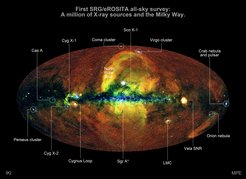The SRG X-ray observatory receives the Marcel Grossmann Institutional Award 2021

An artist’s view of the SRG orbital X-ray observatory.
Several MPA scientists are members of the Russian SRG/eROSITA consortium and played a key role in the mission implementation and in obtaining the all-sky map and producing the eROSITA catalog of X-ray sources. By the decision of the Marcel Grossmann Award Committee the Institutional Award goes to S.A. Lavochkin Association, presented to its Designer General Alexander Shirshakov, the Max Planck Institute for Extraterrestrial Physics, presented to Professor Peter Predehl, Principal Investigator of eROSITA until 2020, and the Space Research Institute (IKI) of the Russian Academy of Sciences, presented to Professor Rashid Sunyaev, Principal Investigator of SRG Observatory in Russia.
The S.A. Lavochkin Association created the Navigator space platform carrying the German eROSITA and the Russian ART-XC X-ray telescopes with grazing incidence optics and organized the launch of SRG orbital X-ray observatory to the second Lagrangian point of the Sun-Earth system at a distance of 1.5 million km from the Earth. It now manages the flight of the observatory, sends commands to the spacecraft and telescopes and performs the daily reception of its scientific data on Earth.
The very successful eROSITA soft X-ray telescope on-board the SRG mission was built by a consortium of German institutes led by the Max Planck Institute for Extraterrestrial Physics and supported by DLR. Thirty years after ROSAT, SRG/eROSITA performs an all-sky survey in X-rays with an unprecedented sensitivity, spectral and angular resolution.
The Space Research Institute (IKI) of the Russian Academy of Sciences was responsible for developing the overall concept and scientific program of the SRG orbital observatory and played a leading role in developing the Mikhail Pavlinsky ART-XC telescope and the entire SRG observatory. Rashid Sunyaev, director-emeritus of the Max Planck Institute for Astrophysics and Maureen and John Hendricks distinguished visiting professor of the Institute for Advanced Study, Princeton, is the Principal Investigator of SRG mission in Russia.

The X-ray RGB map of the sky obtained by the SRG/eROSITA telescope.
The SRG observatory, launched with a Proton-M rocket from Baikonur two years ago on July 13, 2019, started the all-sky survey on December 12, 2019. By the summer of 2021, it scanned the entire sky three times and it is now conducting the 4th survey. In the course of three sky scans, the eROSITA telescope aboard SRG discovered over two million X-ray sources: mainly quasars, stars with hot and bright coronae, and more than 30 thousand clusters of galaxies.
In the search for clusters of galaxies, there is a competition and synergy with the ground-based Atacama Cosmology and South Pole Telescopes, which are searching for clusters of galaxies in the microwave spectral band using the Sunyaev-Zeldovich effect. SRG provided the X-ray map of the entire sky in hard and soft bands, the latter now being best existing one. The huge samples of the X-ray selected quasars at redshifts up to z=6.2 and clusters of galaxies will be used for cosmological tests and detailed studies of the growth of supermassive black holes and the large scale structure of the Universe during and after reionization.
Every day, SRG is scanning about 1% of the sky and the eROSITA telescope is discovering about a half a dozen extragalactic objects, which changed their luminosity by more than an order of magnitude compared to the previous scan half a year ago. Among these highly variable objects are tidal disruption events, connected to the disruption of a star by the enormous tidal forces near a supermassive black hole in the nucleus of the host galaxy. The Mikhail Pavlinsky ART-XC telescope is discovering many bright Galactic and extragalactic transients and absorbed AGN.
The SRG Observatory will continue scanning the sky for another two and a half years and then will start pointed observations of individual targets and deep scans of extended sky regions especially interesting for the scientific teams.

